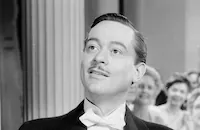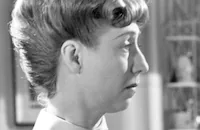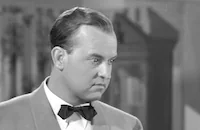Blind Alley
Brief Synopsis
Cast & Crew
Charles Vidor
Chester Morris
Ralph Bellamy
Ann Dvorak
Joan Perry
Melville Cooper
Film Details
Technical Specs

Synopsis
Hal Wilson, a prison inmate serving a sentence for murder, is aided by his former associates in a jailbreak. After their escape, Wilson and his cohorts are sought by the police. The fugitives take refuge in the home of Dr. Shelby, a professor of psychology, while he and his wife Doris are entertaining dinner guests Linda and George Curtis and Dick Holbrook. After the fugitives force everyone, including the Shelby's young son Davy and their two housekeepers, into the basement, they wait for their getaway boat to arrive. When Fred Landis, a young student of Dr. Shelby, shows up to bid the Shelbys farewell before leaving on a trip, he soon realizes what is afoot and challenges one of the gunmen to a fistfight. Fred flattens the gunman, but when he challenges Wilson, Wilson shoots and kills him. Determined to save his family and guests, Dr. Shelby decides to use a psychological offensive to disarm Wilson. Wilson agrees to undergo an impromptu treatment after the doctor proves his expertise by accurately diagnosing that the paralysis in one of his hands is the result of a childhood trauma. Dr. Shelby then manages to extract a confession from Wilson that his mother molested him, and that he murdered his father. Having found the source of Wilson's grief and anxiety, Dr. Shelby tells Wilson that he no will longer be living in a psychological "blind alley" because he has been cured through the process of catharsis, and that henceforth he will be unable to shoot another man because he will imagine his father to be the victim. When the police surround the house and demand that Wilson surrender, Wilson tries to fire at an officer, but is unable to pull the trigger. At that moment, Wilson is shot by an officer and killed.

Director

Charles Vidor
Cast

Chester Morris

Ralph Bellamy

Ann Dvorak

Joan Perry

Melville Cooper

Rose Stradner

John Eldredge

Ann Doran
Marc Lawrence
Stanley Brown

Scotty Beckett

Milburn Stone

Marie Blake

John Hamilton

Grady Sutton
Crew
Lucien Ballard
Lionel Banks
Michael Blankfort
Clifford Broughton
Albert Duffy
Jack Fier
Kalloch
Fred Kohlmar
Philip Macdonald
Lewis Meltzer
Otto Meyer
Donald W. Starling
M. W. Stoloff

Photo Collections
Videos
Movie Clip



Film Details
Technical Specs

Articles
Blind Alley
Blind Alley stars Chester Morris as crazed killer Hal Wilson, who's just busted out of jail, taking the warden as a hostage (Morris's crime-movie credentials include a gazillion Boston Blackie pictures in the '40s). We know he's a killer when he guns the warden down, and we know he's crazed when he gazes at the corpse with a weird expression on his face. A well-organized psychopath, Wilson has a getaway plan a boat will spirit him to a distant hideout and several henchmen, plus a girlfriend, to help him pull it off. All he needs now is a safe place to wait, and the best one available is the waterfront house of Dr. Shelby, a professor of psychiatry played by Ralph Bellamy with his usual suave confidence. The good doctor is spending the evening with various high-toned guests, but Wilson barges right in, herds most of those present into an upstairs bedroom, and shoots a late arrival in cold blood.
The one thing Wilson didn't anticipate is having to match his highly inadequate wits against those of a professor of psychiatry. At first Dr. Shelby humors him, figuring that if the criminal's plan goes as expected, he'll be out of everyone's hair before long. But the getaway boat is way behind schedule, and Wilson starts to get under the psychiatrist's skin, pushing everyone around and saying intellectuals are nuts. To put the creep in his place, Dr. Shelby decides to "take his mind apart and let him see the pieces." This isn't a very hard job Wilson's mind doesn't appear to have many pieces and soon the prof has lured him into talking about his past. Wilson resists, but not very hard, and before you can say "psychopathological" he's vividly describing a recurrent dream about hiding from a rainstorm under an umbrella surrounded by disembodied legs. Analyzing this in a flash, Shelby helps Wilson remember the repressed trauma that's responsible for his murderous nature: After suffering childhood abuse, he betrayed his father to the cops, then cowered under a table as dad's blood dripped down through a hole. Now that his pesky Oedipus complex is neutralized, Wilson is no longer crazed. But he's killed a lot of people, and for 1930s censors that mandated a death sentence, so he doesn't quite make it to the end of the picture. Freud said the superego keeps watch on our morals, and Hollywood had a mighty strong superego back then.
Blind Alley was written by Philip MacDonald, Michael Blankfort, and Albert Duffy, based on a 1935 play by James Warwick, who never had another Broadway success but managed to parlay this story into both the 1939 movie and a 1941 television drama with a different cast, broadcast live from New York when TV was in its infancy. Warwick's play may have been an influence on the 1936 movie The Petrified Forest, which is also about mismatched adversaries stuck together in an isolated place, and The Petrified Forest surely influenced Blind Alley director Charles Vidor when he directed the noir classic Gilda (1946) a few years later. Movies descended from Blind Alley include the 1954 thriller Suddenly, with Frank Sinatra as a would-be presidential assassin who sets up his gun in an innocent widow's house; the 1955 noir The Desperate Hours, directed by William Wyler; and, more tenuously, numerous entries in the home-invasion subgenre.
Blind Alley is weakened by story elements that make as little sense as the surface content of Wilson's dream. Why doesn't Wilson bother to tie up his multiple hostages in Dr. Shelby's home? After forcing them into a bedroom with a thug standing guard, why does he let Dr. Shelby stay in the living room as if he were an old pal? Why doesn't his hostility to brainy people keep him from having a long chat with the conspicuously brainy doc? When a latecomer arrives, why doesn't Wilson just shove him into the bedroom with everyone else, instead of shooting him dead? Why does he tie up the household maids in the basement with nobody making sure they don't escape and call the cops, which is exactly what they do? Et cetera. And if you've had a single day of Psych 101, you'll hoot at Dr. Shelby's explanation of the human mind it's like watching Freud do a guest spot on Oprah.
But silliness like this is one of the pleasures to be found in 69-minute quickies from the late '30s. Deeper pleasures come from the crisp cinematography by Lucien Ballard, who was only a few years into his legendary career. The movie's most visually striking moments are Wilson's dream, which is shown on negative film, and the reenactment of his childhood trauma, which avoids the usual Hollywood gimmicks blurry focus, wobbly compositions in favor of sharply etched images and hallucinatory set design, both of which anticipate Hitchcock's approach in Spellbound. In its review of Blind Alley on New Year's Day of 1939, the trade paper Variety praised Morris as "vigorous" and Bellamy as "quiet and self-assured," and said Vidor's directing, "although slow in several spots, is okay." That's about right, but add a couple of stars if your Oedipus complex has been kicking up lately.
Director: Charles Vidor
Associate Producer: Fred Kohlmar
Screenplay: Philip MacDonald, Michael Blankfort, Albert Duffy, based on the play by James Warwick
Cinematographer: Lucien Ballard
Film Editing: Otto Meyer
Art Direction: Lionel Banks
Cast: Chester Morris (Hal Wilson), Ralph Bellamy (Dr. Shelby), Ann Dvorak (Mary), Joan Perry (Linda Curtis), Melville Cooper (George Curtis), Rose Stradner (Doris Shelby), John Eldredge (Dick Holbrook), Ann Doran (Agnes), Marc Lawrence (Buck), Stanley Brown (Fred Landis), Scotty Beckett (Davy), Milburn Stone (Nick), Marie Blake (Harriet).
BW-69m.
by David Sterritt

Blind Alley
Quotes
Trivia
Notes
According to the file on the film in the MPAA/PCA Collection at the AMPAS Library, the original title of the play on which this film is based was Smoke Screen. As early as October 1935, the Hays Office notified M-G-M that because the story had a gangster hero it was "thoroughly unacceptable," and urged the studio to "dismiss it entirely from any further consideration." Seven months later, the Hays Office reiterated its objections to the film, stating that "the story, as it stands, is basically so bad from the standpoint of the Code that it is irrevocably beyond its pale." It also noted that "the suicide of the gangster, as means of escape from the consequences of his crimes, is in violation of the Code." Following the Hays Office's rejection of the story, M-G-M postponed the film for over two years, until 1938, when the office, in a letter acknowledging the receipt of the first draft of the treatment, stated that the story was "basically satisfactory from the standpoint of the Production Code." The Hays Office went on to caution, however, that the British censors would reject "any material dealing with insane characters and the use of an asylum as a background." It also warned against the discussion of "objectionable subjects" in the scene in which the doctor psychoanalyzes the fugitive, as well as the "flaunting of weapons" and showing details of the crime.
A Hollywood Reporter pre-production news item noted that Rose Stradner was borrowed from M-G-M for the film. Modern sources list Eddie Acuff (State trooper) in the cast, but his appearance in the released film has not been confirmed.
A 1940 Hollywood Reporter news item notes that Edward G. Robinson, James Cagney and Isabell Jewell were featured in a Gulf Screen Actors Guild radio performance of Blind Alley that was broadcast on February 25, 1940. Blind Alley was remade by Columbia in 1948 as The Dark Past. Televised performances of James Warwick's play include the 1949 Studio One production, directed by Paul Nickell and starring Jerome Thor and Bramwell Fletcher, which aired on the CBS television network on January 30, 1949; the Broadway Television Theatre production, starring Roy Hargrove and Beverly Roberts, which aired on non-network television on September 15, 1952; and the Kraft Theatre production, starring Darren McGavin and Herbert Berghof, which aired on the NBC television network on June 10, 1954.














